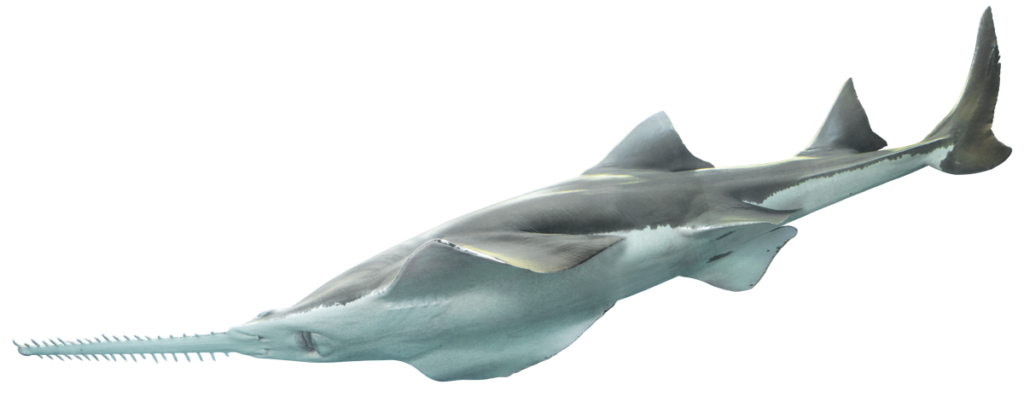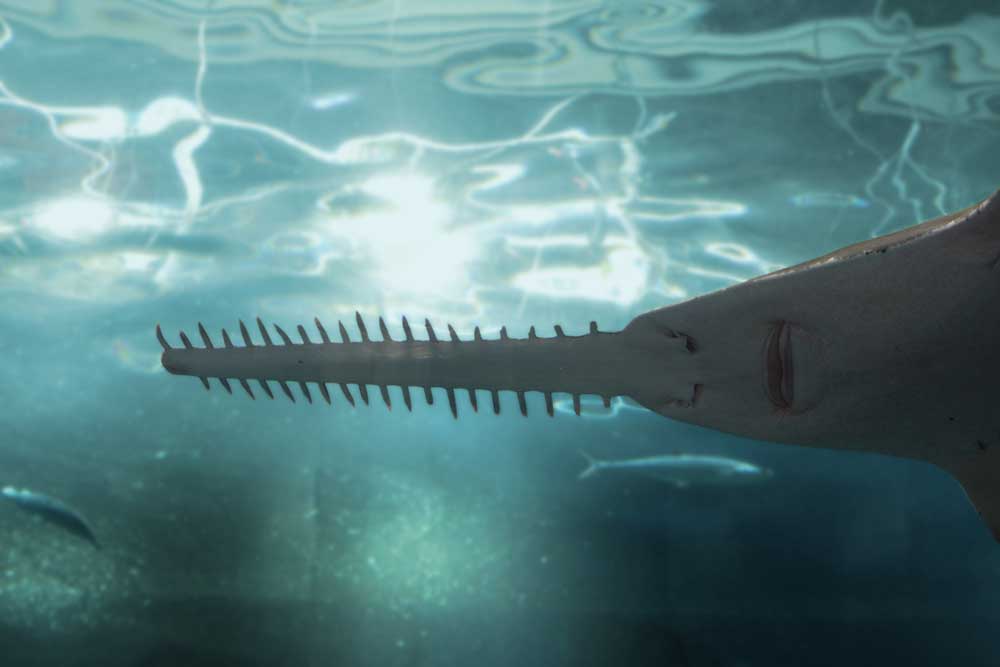
Pristis pristis (Linnaeus, 1758)
ノコギリの使い方
How to use a saw
世界中の熱帯、亜熱帯の沿岸域に分布するノコギリエイで最大で体長6m以上に成長します。ノコギリエイは近年の形態学および遺伝学研究により系統立てられ、本種は2024年にオオノコギリエイという標準和名が与えられました。
特徴的なノコギリは吻が発達したもので、餌を捕る際に振り回して相手を傷を負わせたり、気絶させ、地面に押さえつけるためにあります。ノコギリ刃は吻歯と呼ばれ一度失うと生えてくることはありません。現生ノコギリエイの仲間は2属5種知られていますが、本種は英名が示す通りノコギリの歯が大きく間隔も広いことが特徴です。
謎の多い生態ですが、本種は若い頃に川で育ち成熟すると海に移動する傾向があります。ノコギリエイの中でも特に塩分濃度に柔軟に対応する能力があり、川や海の広い範囲で生息することができるのです。
しかし、ノコギリエイは5種とも絶滅危惧種となっており危機的な状況にあります。フカヒレは食用となり、皮は服飾での利用、その他漢方や薬用としての利用もあり乱獲が脅威となっています。成体になるまで10年かかり、1度の出産数も7 – 9匹なので個体数はなかなか増加することができない現状があります。
This sawfish is found in tropical and subtropical coastal areas around the world and can grow to a maximum length of over 6m. Sawfish have been systematically classified through recent morphological and genetic research, and this species was given the standard Japanese name, Oonokogiriei, in 2024.
The characteristic saw is a developed snout, which is used to catch prey and injure or stun prey, and pin them to the ground. The saw blade is called a snout tooth and will not grow back once it is lost. There are two genera and five species of sawfish known to exist today, but this species, as its English name suggests, is characterized by large saw teeth that are widely spaced apart.
Although its ecology is mysterious, this species tends to grow in rivers when young and migrate to the sea when it matures. Among sawfish, it has the ability to adapt flexibly to salinity, and can live in a wide range of rivers and seas.
However, all five species of sawfish are endangered and in a critical situation. Shark fins are eaten, and their skin is used for clothing, as well as for herbal medicine and other uses, so overfishing is a threat. It takes 10 years for sharks to reach adulthood, and they only give birth to 7-9 pups at a time, so the population is not increasing very quickly.

The chipped blade of the saw is proof of its battle history
参考文献
るるぶKids | “裏の顔”が人気!ノコギリエイの展示は3水族館のみ。性格・特徴、世界唯一展示も | 佐々木 隆 (2020年9月13日) 2025年4月13日閲覧
カラパイヤ | ほう!こうやって使うのか。ノコギリエイのノコギリの使い方 | (2012年3月10日) 2025年4月13日閲覧
“Largetooth sawfish” Animals, National Geographic. 2025年4月13日閲覧
“LARGETOOTH SAWFISH/ FRESHWATER SAWFISH Pristis pristis” Sawfish Conservation Society. 2025年8月31日閲覧
